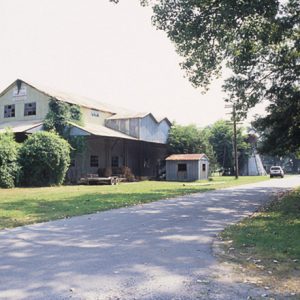calsfoundation@cals.org
Weldon Gin Company Historic District
The Weldon Gin Company Historic District is listed on the National Register of Historic Places for its association with the farming economy of the town of Weldon (Jackson County), as well as for being the only example of cotton gin architecture and technology in Weldon.
By the late antebellum period, Alvin McDonald was farming more than 900 acres just south of the current town of Weldon. Survey maps and federal land records of the period show that McDonald paid $1.25 an acre for just over 930 acres. As was the case with many of his peers in Jackson County, McDonald’s farm income was supplemented rather than supported by cotton. Smaller farmers who could not afford to build their own gin depended on their neighbors, but larger farms and plantations often built and operated ginning facilities. However, between 1866 and 1900, the price of cotton per acre dramatically outpaced the price of other commodities in Arkansas. With the growth of cotton farming in the later part of the nineteenth century, the demand for ginning of raw cotton also grew. Men like Alvin McDonald and his son, Alvin McDonald Jr., were able to convert their farm gin operations to local gin operations.
The Weldon Gin provided ginning services for farmers in the area around Weldon. They shipped their finished cotton bales to the compress at Newport (Jackson County) on the White and Black River Valley Railway. The gin continued to operate at the corner of Weldon Avenue and Washington Street throughout the early twentieth century. There were ownership changes over the years, but the McDonald family always held a controlling interest in the gin. Ralph McDonald, son of Alvin McDonald Jr., operated the gin for many years with his brothers. Operation of the gin focused on ginning the cotton brought in by local farmers and selling that ginned cotton in bales to the compress in Newport. Additionally, when the Newport Cotton Seed Oil Company began operation, the Weldon Gin shipped seed by rail to the seed oil company.
The Weldon Gin Company operated in this fashion into the 1930s. The McDonald Brothers Company, which operated the Weldon Gin Company, watched the cotton markets closely. As the total amount of cotton harvested increased and the price of cotton decreased through the 1920s and 1930s, they found that their old steam-powered gin was not sufficient. The increasing use of the mechanical cotton picker placed additional ginning demand on the Weldon Gin, shortening the amount of time in which to gin the cotton. With increased demand and the possibility of gaining modern efficiencies through electrification and new technology, the McDonald Brothers hired the Continental Gin Company to rebuild the gin at Weldon.
By 1929, the Continental Gin Company was offering a one-story gin outfit made completely of steel. This new design allowed for pumps, motors, engines, and fans to be placed away from the gins themselves. This greatly reduced the maintenance on these items and increased operational efficiency. The new all-steel gin, combined with combination huller-extractor-feeder machines that the company began making in 1934 allowed gin operators to increase production, reduce maintenance, and lower operating costs.
The McDonald Brothers Company installed this new system in the Weldon Gin in 1939. The Continental Gin Company was contracted to build the gin building and install the ginning equipment. The new facility had three gins powered by a 175-horsepower electric motor. These gins were capable of making six to eight bales of cotton per hour, and the gin produced about 3,000 bales per season.
Though the McDonald Brothers Company was able to recover from the Great Depression and make a substantial investment in new technology, the cotton economy of the county had taken severe blow. The White and Black River Valley branch of the Rock Island Railroad was no longer profitable and, in 1940, ceased operation. The railroad lines were removed, and the Weldon Gin Company required the installation of a seed hopper to load truck trailers for delivery to the seed oil company in Newport.
Business remained steady through the 1940s, 1950s, and 1960s because acreage controls set by the federal government ensured a steady, though at times small, harvest each year. During this same period, however, rice continued to become more valuable per acre than cotton. Harvest yields per acre of rice or soybeans were greater than cotton and brought the farmer more money. Gradually, the amount of cotton grown by Jackson County farmers decreased. The complete removal of acreage controls in 1974 continued to reduce cotton harvests. By 1980, the Weldon Gin Company was producing only 1,000 bales a season, well below the capacity of the gins and well below production levels of previous years. Faced with such small production, the Weldon Gin Company no longer considered it to be profitable to operate the gin.
The Weldon Gin Company Historic District was listed on the National Register of Historic Places on June 4, 2008.
For additional information:
Hope, Holly. “Get Down the Shovel and the Hoe: Cotton and Rice Farm History and Architecture in the Arkansas Delta, 1900–1955.” Little Rock: Arkansas History Preservation Program, n.d. Online at http://www.arkansaspreservation.com/pdf/publications/cotton_and_rice_paper.pdf (accessed October 21, 2021).
“Weldon Gin Company Historic District.” National Register of Historic Places nomination form. On file at Arkansas Historic Preservation Program, Little Rock, Arkansas. Online at http://www.arkansaspreservation.com/National-Register-Listings/PDF/JA0525.nr.pdf (accessed October 21, 2021).
Van Zbinden
Travis A. Ratermann
Arkansas Historic Preservation Program
 Early Twentieth Century, 1901 through 1940
Early Twentieth Century, 1901 through 1940 Historic Preservation
Historic Preservation Weldon Gin Company Historic District
Weldon Gin Company Historic District 



Comments
No comments on this entry yet.